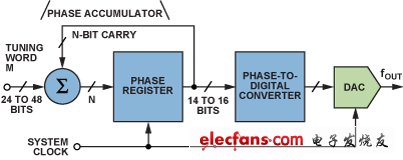Summary
Direct Digital Synthesis (DDS) technology is used to generate and condition high quality waveforms and is widely used in many fields such as medicine, industry, instrumentation, communications, and defense. This article will briefly introduce the technology, explain its strengths and weaknesses, examine some application examples, and introduce some new products that will help the technology.
Introduction
A key requirement in many industries is to accurately generate, easily operate, and quickly change different frequencies and different types of waveforms. Whether broadband transceivers require agile frequency sources with low phase noise and excellent spurious-free dynamic performance, or industrial measurement and control systems require stable frequency excitation to produce tunable waveforms quickly and easily, while maintaining phase The ability to be continuous is a critical design criterion, and this is where the advantages of direct digital frequency synthesis are.
Frequency synthesis task
Increasing spectrum congestion, coupled with the never-ending need for lower power, higher quality measurement equipment, requires the use of new frequency ranges that require better utilization of existing frequency ranges. As a result, better control of frequency generation has been sought, in most cases by means of a frequency synthesizer. These devices use a given frequency, fC, to generate an associated target frequency (and phase), fOUT. Its general relationship can be simply expressed as:
fOUT = εx&TImes; fC
Among them, the scale factor εx, sometimes referred to as the normalized frequency.
This equation is usually implemented using an algorithm of real-time approximation. When the scale factor is a rational number, the ratio of the two relative prime numbers (output frequency to reference frequency) correlates the harmonics. But in most cases, εx may belong to a broader set of real numbers, and the approximation process will be truncated once it is within acceptable limits.
Direct digital frequency synthesis
A practical implementation of frequency synthesizers is Direct Digital Frequency Synthesis (DDFS), often referred to simply as Direct Digital Synthesis (DDS). This technique utilizes digital data processing to produce a frequency and phase tunable output that is associated with a fixed frequency reference or clock source fC. In the DDS architecture, the reference or system clock frequency is divided by a scaling factor to produce the desired frequency, which is programmable by the binary tuning word.
In short, a direct digital synthesizer converts a string of clock pulses into an analog waveform, usually a sine, triangle, or square wave. As shown in Figure 1, the main parts are: phase accumulator (data that produces the phase angle of the output waveform), phase converter, (transform the above phase data into instantaneous output amplitude data), and digital-to-analog converter (DAC) (convert the amplitude data into sampled analog data points)

Figure 1. Functional block diagram of the DDS system.
For sine wave output, the phase to digital converter is typically a sinusoidal lookup table (Figure 2). The phase accumulator counts in N and produces a frequency relative to fC according to the following equation:

among them:
M is the resolution of the tuning word (24 to 48 bits)
N is the number of pulses of fC corresponding to the minimum incremental phase change of the phase accumulator output word.

Figure 2. Typical DDS architecture and signal path (with DAC).
Since changing N immediately changes the output phase and frequency, the system itself has phase continuity and features, which is one of the key attributes of many applications. No loop setup time is required, unlike analog systems such as phase-locked loops (PLLs).
The DAC is typically a high performance circuit designed for the DDS core (phase accumulator and phase amplitude converter). In most cases, the resulting device (usually a single chip) is commonly referred to as pure DDS or C-DDS.
Actual DDS devices typically integrate multiple registers to implement different frequency and phase modulation schemes. For example, the phase register whose stored phase content is added to the output phase of the phase accumulator. Thus, the phase of the output sine wave can be delayed corresponding to a phase tuning word. This is very useful for communication system phase modulation applications. The resolution of the adder circuit determines the number of bits of the phase tuning word and, therefore, the resolution of the delay.
Integrating a DDS engine and a DAC on a single device has both advantages and disadvantages, but whether integrated or not, a DAC is required to produce high-quality analog signals of exceptional purity. The DAC converts the digital sinusoidal output into an analog sine wave, either single-ended or differential. Some key requirements are low phase noise, excellent wideband (WB) and narrowband (NB) spurious free dynamic range (SFDR) and low power consumption. In the case of an external device, the DAC must be fast enough to process the signal, so devices with built-in parallel ports are very common.
Chrismas Candle have many size , such as 3.8g 7g 22g 23g 25g . we can manufacture as your requirments . Large Chrismas Candle usually sell to Jeddah ,Israel ,USA .People decorate the room with Decorative Chrismas candles. the shape of Candle is Pillar and no dripping ,unscented . Our Candles already sell to all of the world .
Any interest,pls feel free to contact
Chrismas Candle
Chrismas Candle,Chrismas Pillar Candles,Large Chrismas Candle,Decorative Chrismas Candle
Shijiazhuang Zhongya Candle Co,. Ltd. , https://www.zycandlefactory.com